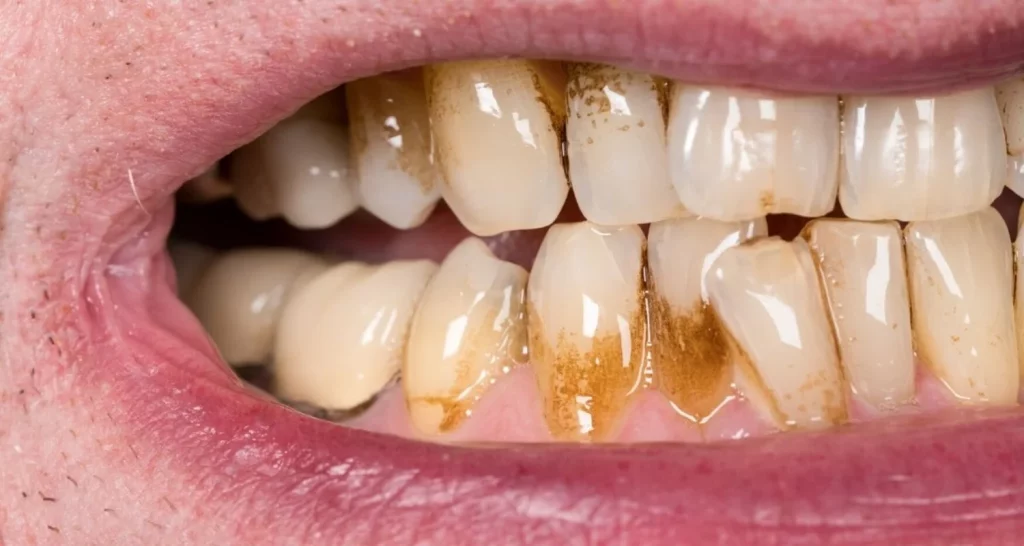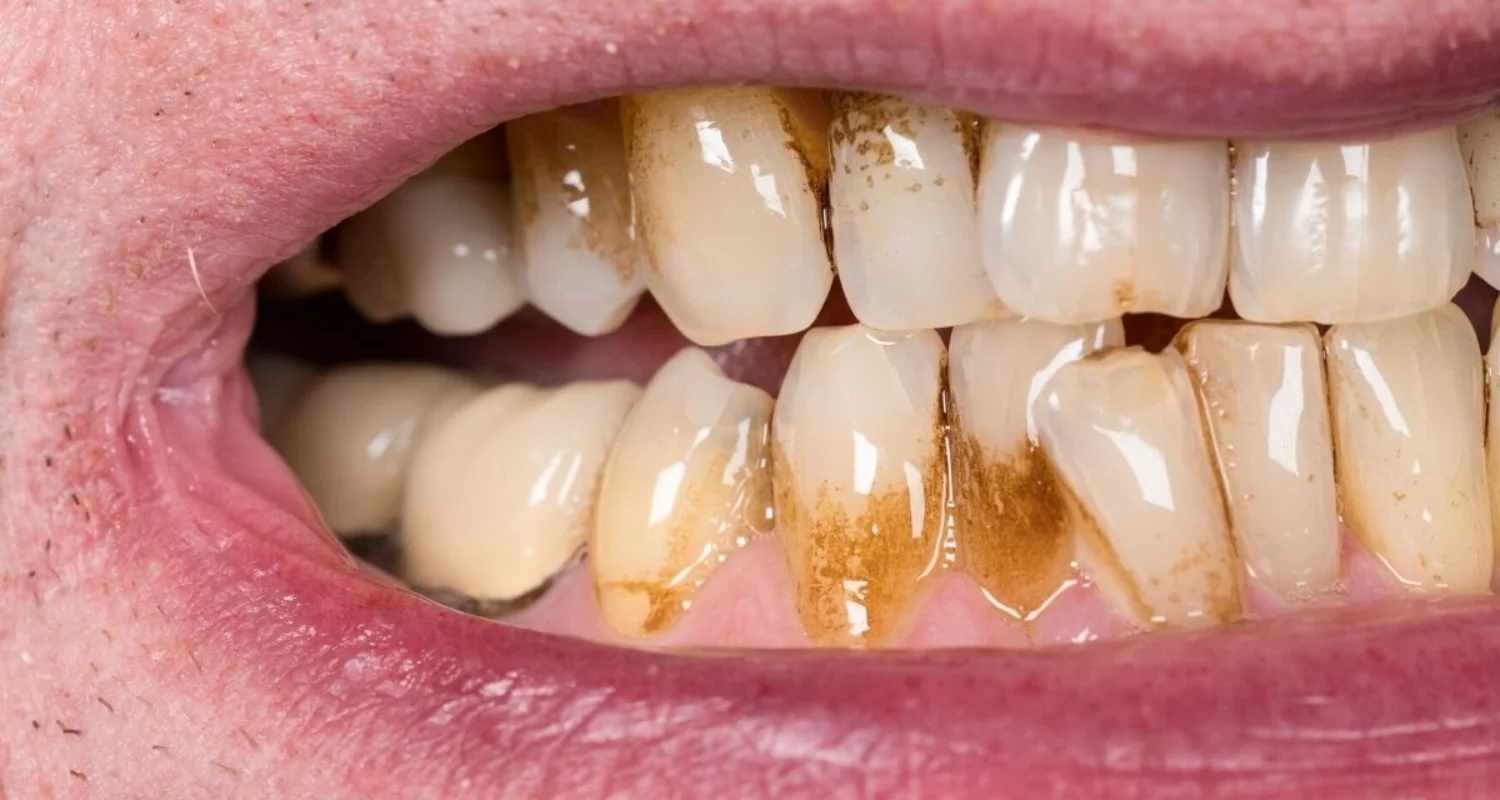Last Updated on: 28th June 2024, 06:54 am
✓ Fact Checked 🕓
❙ Our team of writers, editors, and medical experts rigorously evaluates each article to ensure the information is accurate and exclusively cites reputable sources.
❙ We regularly assess how the content in this article aligns with current scientific literature and expert recommendations in order to provide the most up-to-date research.
What Is Tartar?
Bacterial plaque, which accumulates at the gum margin, plays a crucial role in the development of periodontal disease, and its study has highlighted the importance of dental hygiene. Choosing the right brush, using dental floss, rinses, and other products, as well as brushing techniques, are essential to remove plaque in time and prevent complications.
Good brushing, with adequate frequency and technique, is essential, and it is advisable to consult with the dentist about the most appropriate products and methods to keep gums healthy. A smile with healthy teeth not only has aesthetic value but is also a sign of good dental health.
What is Tartarus?

Tartar, also known as dental calculus, is formed by the accumulation and hardening of dental plaque. This plaque, combined with minerals from saliva, bacteria, and food debris, becomes a hard, sticky layer that adheres to the edges of your teeth and gums. This film, as it hardens, can feel like a rough layer on the tooth enamel. It is usually located on the inner surface of the teeth and can vary in color, from yellow to brown, depending on the accumulation time. If not removed properly, tartar can cause several dental health problems, such as bad breath, enamel damage, and gum disease.
Impact of Tartar on Dental and General Health
Tartar, when it forms below the gum line, is called subgingival tartar. This type develops in the blood vessels of the gum and when it comes into contact with blood, it can acquire a dark pigmentation, known as black tartar. In addition to being a health problem, the presence of yellow or brown tartar can hurt dental aesthetics, affecting self-esteem and social relationships, since it can be perceived as a sign of poor oral hygiene.
The accumulation of tartar is harmful to oral health in general, triggering a series of problems and diseases, such as:
1. Halitosis: Persistent bad breath caused by bacteria that generate sulfuric compounds.
2. Caries: Deterioration of the tooth enamel due to the accumulation of pathogens that damage the tooth and its nerves.
3. Gingivitis: Inflammation, irritation,n, and redness of the gums caused by tartar deposits.
4. Periodontitis: Advanced complication of gingivitis, with an accumulation of tartar in non-visible areas of the gums.
5. Dental Abscesses: Infection that forms a pocket of pus in the gums, often resulting from gingivitis or periodontitis.
6. Systemic Diseases: Cardiovascular and digestive problems may be associated with oral health.
7. Stained and worn teeth: Tartar can stain teeth, especially in the presence of substances such as coffee, tea, wine, and tobacco use, all of which can cause more severe stains.
It is crucial to maintain proper oral hygiene and schedule regular visits to the dentist to prevent and treat these conditions in time.
Dental Tartar Treatment

The only effective method to treat tartar is to see a dentist or dental hygienist. These professionals will safely remove tartar by using special instruments.
Although it may be tempting to try to remove tartar at home, this can damage your teeth and increase your risk of cavities and other dental problems.
Depending upon the amount of tartar accumulated, the dentist may recommend:
Dental cleaning: Regular dental cleanings are essential to maintaining oral health. During the cleaning, the dental hygienist removes plaque and tartar using special instruments, performs thorough flossing between the teeth, and polishes the tooth surfaces with a rubber cup and granulated toothpaste.
Many people control tartar with cleanings every six months. However, if you are prone to cavities, gum disease, or other problems, you may need more frequent cleanings. Consult your dentist about the cleaning schedule that’s right for you.
Treatments for gum disease: If tartar has already caused bone loss around the teeth, your dentist may recommend treatment for gum disease. These procedures remove the tartar trapped under the gum line, where brushing and flossing cannot reach.
Common treatments for gum disease include:
● Scaling and root planing.
● Bone surgery (periodontal pocket reduction surgery).
● Laser periodontal therapy (use of laser energy to eliminate bacteria under the gums).
Strategies to Prevent Tartar Buildup
Preventing the formation of tartar is essential to maintaining good dental health. Below are some key tips:
1. Regular brushing: Brushing at least twice a day for two minutes is essential to prevent tartar formation. Shorter brushing is not enough to remove plaque.
2. Brush choice: It is important to select a brush suitable for your mouth – one that can reach all surfaces, even the most difficult ones. Electric toothbrushes may be more effective in removing plaque. Always look for brushes with an ADA seal of approval.
3. Suitable toothpaste: Use toothpaste that controls tartar or contains fluoride, as it is effective in preventing cavities and tartar. Other options include baking soda or charcoal-based pastes, although their effectiveness may vary.
4. Whitening strips: The hydrogen peroxide with pyrophosphate in whitening strips can help reduce tartar formation.
5. Tea: Drinking tea or using it as a mouthwash can reduce bacteria in the mouth thanks to its antimicrobial activity.

6. Healthy nutrition: Eating fruits and vegetables can promote saliva production and help remove plaque.
7. Use of dental floss: Flossing is essential for removing plaque between teeth and preventing tartar formation.
8. Mouthwash: Mouthwashes with antibacterial ingredients can be helpful, but they are most effective when combined with brushing and flossing.
9. Feeding habits: Reducing the consumption of foods rich in sugars and carbohydrates that stick to the teeth can prevent the formation of acids that are harmful to the enamel.
10. Avoid Smoking and Vaping: Nicotine increases the formation of tartar and plaque.
Additionally, regular visits to the dentist are crucial for professional cleaning and personalized advice. Once the tartar is formed, only a dental professional can safely remove it. Check-ups every 6 months are recommended to maintain a healthy mouth.
Conclusion
In summary, maintaining good oral health is essential to avoid complications such as root cavities, periodontal disease, and tartar accumulation, which can lead to more serious problems such as tooth loss and systemic diseases. It is crucial to adopt a rigorous oral hygiene routine, including brushing, flossing, and mouthwashing, along with regular visits to the dentist for professional cleanings and targeted treatments. Preventing the formation of tartar and treating any oral condition in time is key to preserving dental and general health.
Frequently Asked Questions
What is tartar?
Tartar is a hardened form of dental plaque (a sticky biofilm of bacteria). When plaque remains on the teeth for long periods, minerals from saliva are incorporated into the plaque, causing it to harden and adhere firmly to the surfaces of the teeth.
Is it possible for tartar to come off the teeth?
Excessively hard brushing and certain ways of eating can cause tartar to loosen from the teeth. If you notice that something is coming off your teeth, it is advisable to schedule a visit with your dentist.
What is the function of tartar?
Tartar is a hardened plaque. It forms at, below, and above the gum line, and can irritate the gingival tissues. Since tartar on your teeth gives dental plaque more surface area to accumulate and a much stickier surface to adhere to, it can lead to cavities and gum disease.
Can flossing remove tartar?
Unlike plaque, you can’t remove tartar with brushing and flossing. A dentist or dental hygienist must remove it during a professional dental cleaning. Another name for tartar is dental calculus.
Share:
References
1. Parker, H. (Apr, 2023). What is Tartar? 6 Tips to Control Buildup. Webmd. https://www.webmd.com/oral-health/tartar-dental-calculus-overview
2. Cleveland Clinic. (Jun, 2023). Tartar. https://my.clevelandclinic.org/health/diseases/25102-tartar
3. Kulkarni, P., Singh, D. K., & Jalaluddin, M. (2017). Comparison of Efficacy of Manual and Powered Toothbrushes in Plaque Control and Gingival Inflammation: A Clinical Study among the Population of East Indian Region. Journal of International Society of Preventive & Community Dentistry, 7(4), 168–174. https://doi.org/10.4103/jispcd.JISPCD_133_17
4. Lashkari C. (Feb, 2019). What is Tartar?. News Medical Life Sciences, News-Medical.net. https://www.news-medical.net/health/What-is-Tartar.aspx
5. Parker, H. (Agu, 2020) What is Tartar? 6 Tips to Control Buildup. WebMD (internet). https://www.webmd.com/oral-health/guide/tartar-dental-calculus-overview#:~:text=Tartar,%20also%20called%20calculus,%20forms,tools%20in%20the%20dentist
6. ICPA Health. (Jun 2018). What is tartar and how bad it really is for your oral health?. https://www.icpahealth.com/blog/what-is-tartar-and-how-bad-it-really-is-for-your-oral-health/














